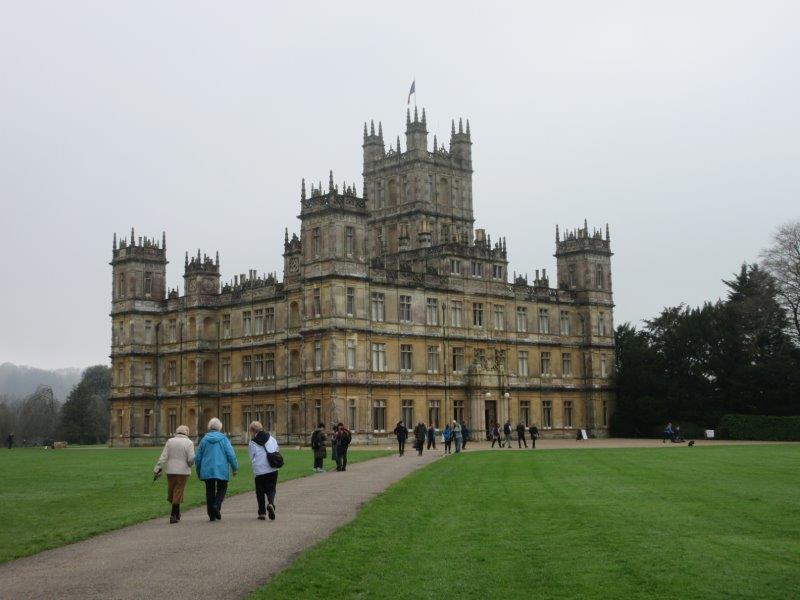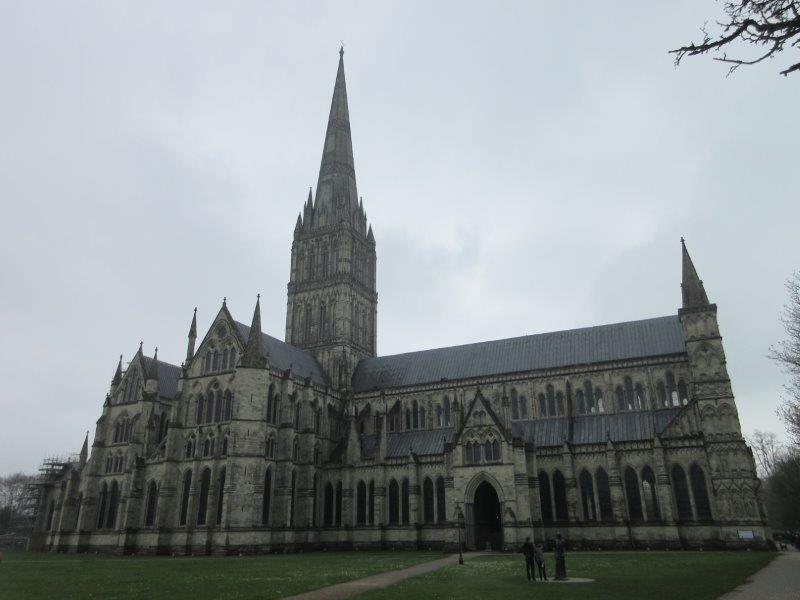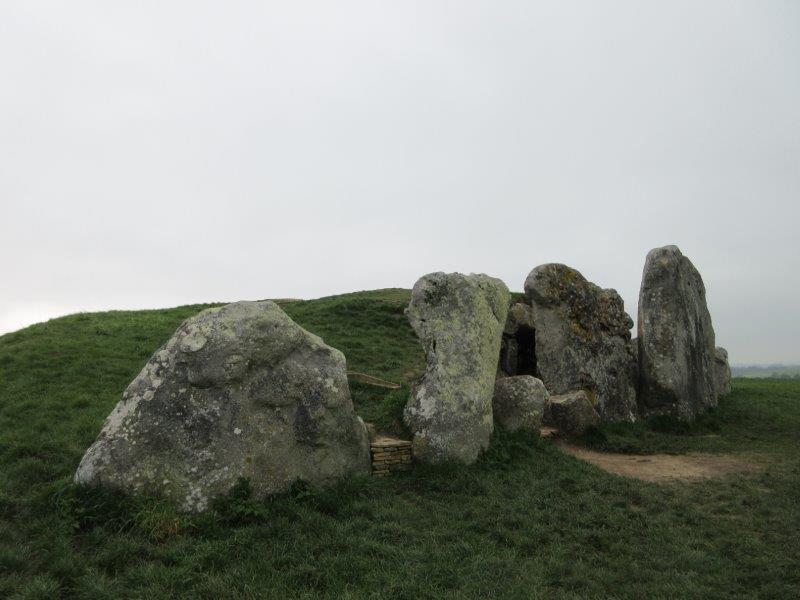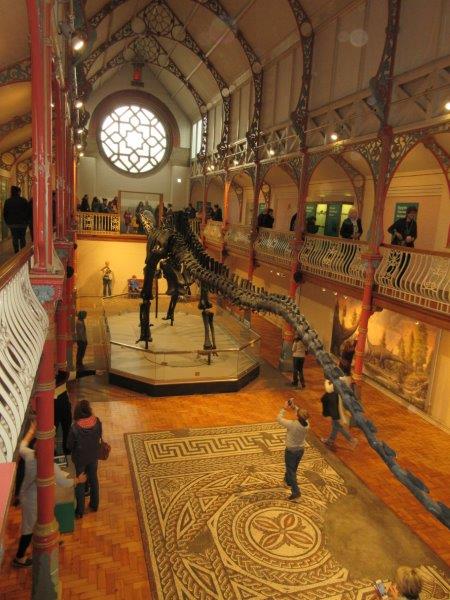YANT Holiday Archives 2018
Holidays Organiser: Peter Drew 01904 702285 holidays@yant.org.uk
Other 2018 Holidays
An Archaeologist's view of Wessex
10th - 14th April, 2018
Holiday Review: An Archaeologist's view of Wessex
10th - 14th April, 2018
On a cool morning in April we travelled to Salisbury breaking our journey at Highclere Castle in Hampshire. This country house built in the Jacobethan style by the architect Charles Barry with a park designed by Capability Brown is best known as the fictional Downton Abbey in the award winning period drama. The seat of the Earl’s of Carnarvon, it was the 5th Earl who with his colleague Howard Carter discovered the tomb of Tutankhamun in 1922 and the Castle houses an interesting Egyptian Exhibition in the cellars.
Our archaeological tour began in earnest the next day with a visit to Stonehenge, one of the most famous prehistoric monuments and a UNESCO World Heritage site believed to have been constructed between 3000 and 2000 BC. We visited the exhibition centre and stepped inside Neolithic houses to discover the tools and objects of everyday life before exploring the standing stones equipped with audio guides.
We returned to Salisbury to view the archaeological collections in the Museum situated in the medieval Kings House, followed by a guided tour of the adjacent Cathedral which boasts the tallest spire, largest cloister and cathedral close in the country as well as containing one of the world’s oldest working clocks and the best surviving of four original copies of the Magna Carta.
The following day we visited Silbury Hill which loomed mysteriously out of the mist. This man-made prehistoric chalk mound was probably completed around 2400 BC and is roughly contemporary with the Egyptian pyramids. In the nearby village of Avebury we explored the three stone circles of the Neolithic henge monument which partially encompass it. The archaeologist Alexander Keiller excavated here in the 1930’s and we visited the museum bearing his name.
Avebury Manor reflects the period styles in which the residents once lived from the Tudor age to the eve of World War II and here we were encouraged to touch the objects, sit on the furniture, play snooker in the Billiard Room and even lie on the beds. We returned to the ancient landscape where a hardy few navigated a muddy path through a waterlogged field to climb the hill to West Kennet Long Barrow, a most impressive and accessible Neolithic chambered tomb built around 3650 BC.
The next day we visited Maiden Castle, a fortified Iron Age hillfort the size of around 50 football pitches. Mostly built in the 1st century BC with huge multiple ramparts designed to protect its residents it would have towered over the surrounding landscape.
We continued to the Dorset County Museum in Dorchester where the collections include fossils from the Jurassic Coast and original Thomas Hardy manuscripts although the main attraction on the day was Dippy the Dinosaur, a 26m diplodocus skeleton cast on tour from the Natural History Museum. Fishbourne Roman Palace, the largest residential Roman building discovered in Britain was our next stop. The exceptional mosaic floors date from around 75 AD and are preserved in an on-site museum.
On our final day we visited The Vyne, a 16th century country house in Hampshire built for Lord Sandys the Lord Chamberlain to Henry VIII and the Tudor chapel with its beautiful stained glass windows dates from this time. The house itself was sheathed in scaffolding as a £5.4m roof project nears its end, but the sun was shining and we enjoyed the beautiful gardens with their many spring flowers.
We were comfortably returned to York by our excellent driver Darren, all a little wiser thanks to our knowledgeable guide Clive Warsop whose energy and enthusiasm for his subject is boundless.
Anne Richardson
Holiday Itinerary: An Archaeologist's view of Wessex
10th - 14th April, 2018
Day 1 -Tuesday 10 April 2018
We depart York and head south, stopping en route for lunch (not included) in a local pub. Then we will enjoy a visit to Highclere Castle, instantly recognizable as the fictional Downton Abbey. We tour the main state rooms and castle bedrooms, as featured in ‘Downton Abbey’. Included is a tour of the Egyptian Exhibition, which tells the story and contains antiquities from the tombs that were discovered in Egypt by the 5th Earl of Carnarvon and Howard Carter. Then on to our hotel in Salisbury for a welcome drink followed by dinner.
Day 2 - Wednesday 11 April 2018
After breakfast we head for Stonehenge. Archaeologists cannot agree on exactly when these massive stones were erected, with estimates ranging from 3000 BC to 2200 BC. Nor can they agree on where the stones came from – for much of the 20th century it was believed that the bluestones were transported by humans from the Preseli Hills, 160 miles away in modern-day Pembrokeshire in Wales, which would have been a most remarkable accomplishment as each one weighs around 4 tonnes. Another theory is that they were brought much nearer to the site as glacial erratics by the Irish Sea Glacier.
In the afternoon we return to Salisbury, to visit the Museum, in the King’s House a Grade 1 listed building, in the glorious setting of the Cathedral Close, the history of which stretches back to the 13th Century. It formerly housed a teacher training college and was the inspiration for an episode in Thomas Hardy’s novel Jude the Obscure. The main strength of the Museum rests in its archaeological collections: these include prehistoric material from South Wiltshire, including Stonehenge; the Pitt Rivers' Wessex collection; and a fine medieval collection including finds from Old Sarum, Clarendon Palace and the city itself. We then cross to the adjacent Cathedral, one of the finest medieval cathedrals in Britain. Started in 1220, it was completed by 1258, with its spire, the tallest in England (123m/404ft) added a generation later. Built to reflect the glory of God in stone and glass this majestic and awe-inspiring church has been a setting for great occasions and huge colourful processions for over 775 years. Dinner is served back at our hotel in the evening.
Day 3 - Thursday 12 April 2018
This morning we travel to the stone circle at Avebury, one of the finest and largest megalithic monuments in Europe and a World Heritage Site. The large stone circle, which encloses two smaller circles, encompasses part of the village of Avebury, is approached by an avenue of stones. It is speculated that the inner circles were created first in about 2600 BC while the outer circle and ditch were created later in 2500 BC. Each of the stones is suspected to weigh upwards of 40 tons with heights that measure over twenty feet thus implying that the local inhabitants must have worked together in order to complete the Avebury Ring. Many of the stones were re-erected in the 1930s by the archaeologist Alexander Keiller.
After a brief visit to the chalk mound of Silbury Hill, the tallest man-made prehistoric mound in Europe, we will continue to West Kennet Long Barrow, one of the largest, most impressive and most accessible Neolithic chambered tombs in Britain. Built in around 3650 BC, used for a short time as a burial chamber, nearly 50 people being buried here before the chambers were blocked. It is thought that this tomb was in use for as long as 1,000 years and at the end of this period the passage and chamber were filled to the roof by people who used Beaker pottery with earth and stones, among which were found pieces of Grooved ware and Peterborough ware, charcoal, bone tools and beads. It has been suggested that this secondary material had been collected from a nearby 'mortuary enclosure' showing that the site had been used for ritual activity long after it was used for burial. We return to the hotel where dinner is served in the evening.
Day 4 - Friday 13 April 2018
This morning we visit Maiden Castle, near Dorchester, the largest and most complex Iron Age hill fort in Britain. The castle was first laid out in 600BC over the remains of a Neolithic settlement. During the following centuries the hill fort was extended and additional defences thrown up around it. The vast multiple ramparts enclose an area the size of 50 football pitches, and the site was home to several hundred people in the Iron Age (750 BC - 43 AD). Excavations here have revealed that occupation of this hilltop began over 6,000 years ago, in the Neolithic period. In AD43 it was taken by the Roman army and its inhabitants moved to the new town of Durnovaria, modern Dorchester. We continue to the Dorchester Museum, whose extensive collection includes artefacts from the conflict with the Romans at Maiden Castle. The nostalgic and atmospheric Victorian Hall also contains examples of Roman mosaics. The Roman theme is continued at our final visit today, Fishbourne Roman Palace, discovered by accident during the digging of a water main trench in 1960.
This led to nine seasons of excavations that showed the site had developed from a military base at the time of the Roman invasion in 43 AD to a sumptuous Palace by the end of the first century. Between 1995 and 2002, new excavations revealed new insights into this site, and especially the area in front of the Palace. The Fishbourne Roman Museum has undergone a £3.5 million pounds Heritage Lottery funding development, including new lighting over the spectacular Roman mosaics. A brand new audio-visual with stunning computer graphics reconstructing the Palace as it was and you can handle actual Roman objects in the brand new Collections Discovery Centre. We return to the hotel where dinner is served in the evening.
Day 5 - Saturday 14 April 2018
After check out we begin our homeward journey with a visit to Basildon Park, near Reading. This beautiful Palladian mansion features in the 2005 film of Jane Austen's Pride and Prejudice. Built in 1776-83 by John Carr for Francis Sykes, who had made his fortune in India, the interior is notable for its original delicate plasterwork and elegant staircase and the unusual Octagon Room. The house fell on hard times in the early part of the last century, but was rescued by Lord and Lady Iliffe, who restored it and filled it with fine pictures and furniture. The early 19th-century pleasure grounds are currently being restored, and there are waymarked trails through the parkland. Following our tour we will have a light lunch then return home to York.
Included in price
• Four nights’ DBB at the Red Lion Hotel, Salisbury
• Welcome drink
• Comfortable coaching from York
• Visits to Stonehenge, Salisbury Museum, Salisbury Cathedral, Avebury, Silbury Hill, Maiden Castle, Dorchester Museum, Fishbourne Roman Palace, Basildon Park, Highclere Castle
• Services of Clive Warsop as guide
• Porterage & Gratuities
Not included (per person)
• Single Occupancy Supplement £230.00
• Insurance






























